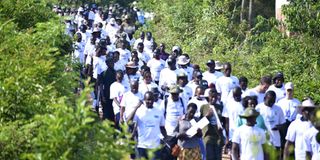Concerted efforts to save River Kibos

Participants during the second leg of the walk along the tributary of River Kibos in Nandi County.
Human encroachment, widespread sand harvesting, pollution and illegal abstractions along river Kibos is posing a great challenge to the provision of clean and safe water to over 500,000 residents of Kisumu City.
With tributaries in Nandi, Vihiga and Kisumu counties, the three counties have committed to conserve and protect the trans-county river from unprecedented degradation.
Considering that Kenya is a water-scarce country, Water and Sanitation PS Julius Korir underlined the need for a concerted effort to achieve universal access to the essential commodity.
“Currently around 40 per cent of the Kenyan population lack access to safe drinking water while 9.9 million individuals rely on contaminated surface water sources,” he said.
The PS who spoke while flagging off the annual national campaign on the need to protect and save key water catchment areas noted as alarming that over 100 rivers have dried up over the last three decades.
Water campaign
“From 167 rivers in the early 1990s, we only have 67 rivers currently,” he said during the start of a three-day walk at the source of river Kibos at Kobujoi village in Nandi County last week.
The Journey of water campaign led by World Wide Fund for Nature Kenya (WWF-Kenya) sought to raise awareness about water conservation and the importance of protecting rivers and water sources.
WWF-Kenya Fresh Water Lead Dr William Ojwang said the campaign shares with citizens the need to secure water catchments.
If nothing is done urgently, he said, over 60 per cent of Kisumu residents will be hit by interrupted water supply.
Kisumu’s main water supplier, the Kisumu Water and Sanitation Company (Kiwasco) currently splits water production with river Kibos serving 60 per cent while Dunga (which abstracts water from Lake Victoria) serves 40 per cent.
Kiwasco MD Thomas Odongo says drawing water from River Kibos is much cheaper since it uses gravity to supply the commodity as opposed to Dunga which is pumped using electricity.
To support the conservation and rehabilitation of River Nyang’ori and Kibos water sources, WWF-Kenya granted Kiwasco Sh10 million in October 2023.
Consequently, the water utility has contributed to rehabilitation of Kajulu Forest in Kisumu by planting over 10,000 trees and currently undertaking stakeholder consultation to gazette the catchment area.
Nandi, Vihiga and Kisumu counties have also committed to establish a joint water resource facility geared towards boosting their resource envelope and that of development partners by increasing allocation to water resources management by at least 2.5 per cent of line department budget.
As custodians of water catchments and water resources, PS Korir noted that the ministry will bring together communities, experts and policymakers to take meaningful actions toward sustainable water management and environmental conservation.
He pointed out that the Intergovernmental Water Sector Coordination Framework which was signed and will soon be operationalised.
“The framework is critical for water conservation because it represents all stakeholders, from the national and county Governments to the communities living within the basins and other key stakeholders,” said the PS.
Mr Korir further noted that the ministry is engaging with stakeholders on modalities of establishing the Basin Water Resources Committees.





